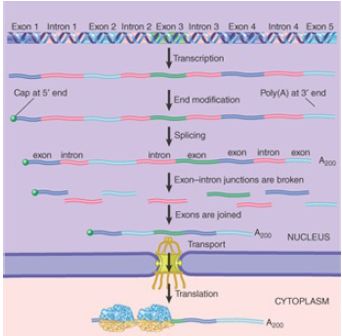


 النبات
النبات
 الحيوان
الحيوان
 الأحياء المجهرية
الأحياء المجهرية
 علم الأمراض
علم الأمراض
 التقانة الإحيائية
التقانة الإحيائية
 التقنية الحيوية المكروبية
التقنية الحيوية المكروبية
 التقنية الحياتية النانوية
التقنية الحياتية النانوية
 علم الأجنة
علم الأجنة
 الأحياء الجزيئي
الأحياء الجزيئي
 علم وظائف الأعضاء
علم وظائف الأعضاء
 الغدد
الغدد
 المضادات الحيوية
المضادات الحيوية|
Read More
Date: 20-4-2021
Date: 8-5-2016
Date: 18-11-2020
|
Introduction to The RNA Splicing and Processing
RNA is a central player in gene expression. It was first characterized as an intermediate in protein synthesis, but since then many other RNAs that play structural or functional roles at various stages of gene expression have been discovered. The involvement of RNA in many functions involved with gene expression supports the general view that life may have evolved from an “RNA world” in which RNA was originally the active component in maintaining and expressing genetic information. Many of these functions were subsequently assisted or taken over by proteins, with a consequent increase in versatility and probably efficiency.
All RNAs studied thus far are transcribed from their respective genes and (particularly in eukaryotes) require further processing to become mature and functional. Interrupted genes are found in all groups of eukaryotic organisms. They represent a small proportion of the genes of unicellular eukaryotes, but the majority of genes in multicellular eukaryotic genomes. Genes vary widely according to the numbers and lengths of introns, but a typical mammalian gene has seven to eight exons spread out over about 16 kb. The exons are relatively short (about 100 to 200 bp), and the introns are relatively long (almost 1 kb) .
The discrepancy between the interrupted organization of the gene and the uninterrupted organization of its mRNA requires processing of the primary transcription product. The primary transcript has the same organization as the gene and is called the pre-mRNA.
Removal of the introns from pre-mRNA leaves an RNA molecule with an average length of about 2.2 kb. Removal of introns is a major part of the processing of RNAs in all eukaryotes. The process by which the introns are removed is called RNA splicing.
Although interrupted genes are relatively rare in most unicellular/oligocellular eukaryotes (such as the yeast Saccharomyces cerevisiae), the overall proportion underestimates the importance of introns because most of the genes that are interrupted encode relatively abundant proteins. Splicing istherefore involved in the productio n of a greater proportion of total mRNA than would be apparent from analysis of the genome, perhaps as much as 50%.
One of the first clues about the nature of the discrepancy in size between nuclear genes and their products in multicellular eukaryotes was provided by the properties of nuclear RNA. Its average size is much larger than mRNA, it is very unstable, and it has a much greater sequence complexity. Taking its name from its broad size distribution, it is called heterogeneous nuclear RNA (hnRNA).
The physical form of hnRNA is a ribonucleoprotein particle, hnRNP, in which the hnRNA is bound by a set of abundant RNA-binding proteins. Some of the proteins may have a structural role in packaging the hnRNA; several are known to affect RNA processing or facilitate RNA export out of the nucleus.
Splicing occurs in the nucleus, together with the other modifications that are made to newly synthesized RNAs. The process of expressing an interrupted gene is reviewed in FIGURE 1. The transcript is capped at the 5′ end, has the introns removed, and is polyadenylated at the 3′ end. The RNA is then transported through nuclear pores to the cytoplasm, where it is available to betranslated.

FIGURE .1 RNA is modified in the nucleus by additions to the 5′ and 3′ ends and by splicing to remove the introns. The splicing event requires breakage of the exon–intron junctions and joining of the ends of the exons. Mature mRNA is transported through nuclear pores to the cytoplasm, where it is translated.
With regard to the various processing reactions that occur in the nucleus, we should like to know at what point splicing occurs vis-àvis the other modifications of RNA. Does splicing occur at a particular location in the nucleus, and is it connected with other events—for example, transcription and/or nucleocytoplasmic transport? Does the lack of splicing make an important difference in the expression of uninterrupted genes?
With regard to the splicing reaction itself, one of the main questions is how its specificity is controlled. What ensures that the ends of each intron are recognized in pairs so that the correct sequence is removed from the RNA? Are introns excised from a precursor in aparticular ord er? Is the maturation of RNA used to regulate gene expression by discriminating among the available precursors or by changing the pattern of splicing?
Besides RNA splicing to remove introns, many noncoding RNAs also require processing to mature, and they play roles in diverse aspects of gene expression.



|
|
|
|
التوتر والسرطان.. علماء يحذرون من "صلة خطيرة"
|
|
|
|
|
|
|
مرآة السيارة: مدى دقة عكسها للصورة الصحيحة
|
|
|
|
|
|
|
نحو شراكة وطنية متكاملة.. الأمين العام للعتبة الحسينية يبحث مع وكيل وزارة الخارجية آفاق التعاون المؤسسي
|
|
|